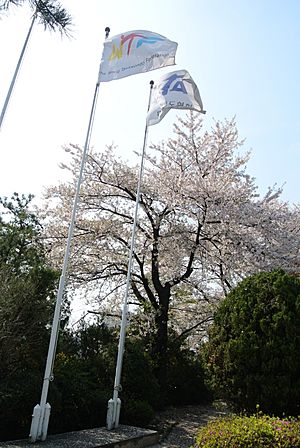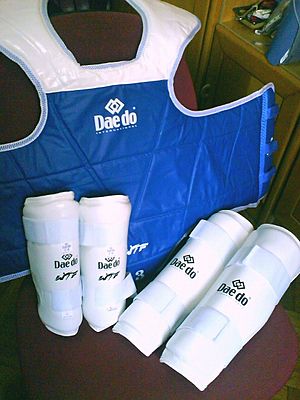World Taekwondo facts for kids
|
세계 태권도 연맹
|
|
 |
|
| Abbreviation | WT |
|---|---|
| Formation | May 28, 1973 |
| Purpose | Martial art and sport |
| Headquarters | Sejongdaero 55, Jung-gu, Seoul, South Korea Lausanne, Switzerland |
| Location |
|
|
Region served
|
Worldwide |
|
Membership
|
213 national associations |
|
Official language
|
English, Korean, French and Spanish |
|
President
|
Choue Chung-won |
| Website | worldtaekwondo.org |

World Taekwondo (WT) is a big international group that manages the sport of taekwondo. It used to be called the World Taekwondo Federation until June 2017. WT is also a member of the Association of Summer Olympic International Federations (ASOIF). This means it helps organize taekwondo in the Summer Olympics.
The World Taekwondo Federation started on May 28, 1973. Its first meeting was held at the Kukkiwon in South Korea. Representatives from 35 countries were there. As of 2022, World Taekwondo has 212 member countries. Choue Chung-won has been the president since 2004.
The International Olympic Committee (IOC) officially recognized World Taekwondo on July 17, 1980. Taekwondo was first shown as a demonstration sport at the 1988 Summer Olympics in Seoul. Later, on September 4, 1994, taekwondo became an official sport for the 2000 Summer Olympics. This was decided at an IOC meeting in Paris, France.
Contents
How World Taekwondo Works
World Taekwondo has a few main parts that help it run smoothly. These include the General Assembly, the World Taekwondo Council, the President, and the Secretariat. Other groups, like the Continental Unions, also work with World Taekwondo.
The General Assembly is like the main meeting for all members. It is the highest decision-making body for World Taekwondo. Its decisions are final.
The World Taekwondo Council includes the President, Vice Presidents, and other important members. This group plans and manages how World Taekwondo operates. They also look after the money and financial reports.
The President is chosen by the General Assembly for a four-year term. The President leads World Taekwondo and represents it to the world. They also lead meetings and assign duties to Vice Presidents. The President also chooses the leaders and members of different committees.
The Secretariat is located at the World Taekwondo headquarters. This team helps the President and Secretary General with their daily tasks.
History of World Taekwondo
The World Taekwondo Federation (WTF) was created on May 28, 1973. This happened after it separated from another group, the International Taekwon-Do Federation, due to political reasons. At that time, Un Yong Kim was chosen as the first president.
The Secretariat, which handles the daily work, started operating on June 3, 1973. World Taekwondo later joined other big sports groups. In the 1970s, taekwondo unions were formed in Europe, Asia, Pan America, and Africa. The Oceania Taekwondo Union was recognized later, in 2005.
A big moment was when the IOC recognized World Taekwondo in Moscow on July 17, 1980. This helped taekwondo become an Olympic sport. Taekwondo was a demonstration sport at the 1988 and 1992 Olympics. On September 4, 1994, it became an official sport for the 2000 Summer Olympics.
After its first appearance as an Olympic sport in 2000, taekwondo was confirmed for the 2004 and 2008 Olympics. In 2004, Chung Won Choue became the new President of World Taekwondo. Taekwondo was also confirmed for the 2012 Summer Olympics.
Goals of World Taekwondo
World Taekwondo's main goal is to manage taekwondo as an Olympic and Paralympic sport around the world.
They want to:
- Help taekwondo grow and get better everywhere.
- Promote fair play, help young people develop, and encourage education through sport.
- Encourage peace and teamwork by participating in sports.
- Organize international taekwondo competitions.
- Keep improving the rules for competitions, including for the Olympic and Paralympic Games.
- Make World Taekwondo stronger and protect the interests of the taekwondo community.
World Taekwondo works with other groups to achieve these goals. These groups include the World Taekwondo Academy and the World Taekwondo Peace Corps.
Countries and Regions in World Taekwondo
As of 2022, World Taekwondo has 212 national member associations. These are spread across five continents.
Continental Groups
- The Pan American Taekwondo Union (PATU)
- 45 national member associations
- The European Taekwondo Union (ETU)
- 51 national member associations
- The African Taekwondo Union (AFTU)
- 52 national member associations
- The Asian Taekwondo Union (ATU)
- 43 national member associations
- Oceania Taekwondo Union (OTU)
- 19 member national associations
Member Countries
| Pan America | |||
|---|---|---|---|
| Europe | |||
|---|---|---|---|
|
|
| Asia | |||
|---|---|---|---|
| Oceania | |||
|---|---|---|---|
Taekwondo Sparring Rules
In World Taekwondo and Olympic rules, sparring is a full-contact event. Two competitors fight on a matted octagon that is 8 meters wide.
Points are scored using an electronic system. This system is built into special "Protector and Scoring Systems" (PSS). When PSS are used, judges also use manual scoring devices.
There are two main ways a taekwondo contest can be run.
Standard Sparring Form
In this form, the fight has three rounds. The athlete with the most points at the end of these rounds wins. If there's a tie, they go into an extra round called "Golden Point." If no one scores a point in Golden Point, the person with more hits registered on the PSS wins. If one athlete cannot continue because of a legal move by their opponent, the other athlete wins immediately.
Best of Three System
In this system, the contest also has three rounds, each lasting two minutes. The person who scores the most points in a round wins that round. The overall winner is the one who wins the most rounds out of the three.
How Points Are Scored
Points are given for strong and accurate moves to specific areas. Light touches do not score points. Here's how points are awarded:
- 1 point for a punch to the chest.
- 1 point if the opponent gets a "Gam-jeom" (penalty).
- 2 points for a regular kick to the chest.
- 3 points for a regular kick to the head.
- 4 points for a turning kick to the chest.
- 5 points for a turning kick to the head.
World Taekwondo updated its rules in November 2016. These changes were made to make the sport more exciting. They encourage more attacking moves and simplify how penalties are given. These new rules started in January 2017.
Since 2009, a kick or punch to the hogu (body protector) scores one point. A spinning kick to the hogu gives an extra point. A kick to the head scores three points. As of October 2010, a turning kick to the head gives an extra point. Punches to the head are not allowed. Since March 2010, knocking down an opponent does not give extra points beyond the points for the strike itself.
The referee can give penalties, called "gam-jeom," for breaking rules. This includes hitting forbidden areas, falling, or trying to stop the match.
Before 2009, a match would end if one person had a 7-point lead or reached 12 points. These rules were removed in 2009. However, in October 2010, World Taekwondo brought back a point gap rule. Now, if a competitor has a 12-point lead at the end of the second round, or at any point in the third round, the match ends. The person with the lead wins.
Anyone can compete in World Taekwondo events. You just need to be a member of your country's World Taekwondo National Association. These associations are open for anyone to join.
WT World Ranking System
Since 2017, there's a new system for ranking athletes in competitions. Tournaments are given a "G" value, which shows how many points an athlete gets for winning. For example, the Olympics is a G-20 tournament. This means winning it gives five times more points than winning a Continental Championship (a G-4 tournament).
To earn points in these competitions, athletes need a Global License. This license lets them earn points in any country that hosts a World Taekwondo event.
| Grade | Competition |
|---|---|
| G1 | WT Sanctioned tournaments |
| World University Championships | |
| Multi-Sport Games | |
| World Military Championships | |
| G2 | WT Sanctioned tournaments |
| Universiade | |
| Military World Games | |
| G4 | Grand Prix Series |
| Continental Championships | |
| Continental Multi-Sport Games (with 4-year cycle) | |
| G8 | Grand Prix Final |
| G12 | World Taekwondo Championships |
| G20 | Summer Olympics |
Points are calculated using this formula:
- Athlete's Rank in Tournament x Tournament Grade
Here's how the "rank" is usually given:
- The first-place athlete gets a rank of 10.
- The second-place athlete gets a rank of 6 (60% of first place).
- The third-place athlete gets a rank of 3.6 (60% of second place).
- The fourth-place athlete gets a rank of 2.16 (60% of third place).
After fourth place, the percentage used is usually 70% instead of 60%.
Example: If an athlete finishes 3rd in a G-8 event, they get: (10 points x 60% x 60%) x 8 = 28.8 points.
How Athlete Points Change Over Time
When an athlete earns points, those points stay with them for four years. Each year, 25% of the original points are removed from their total. This means points slowly decrease over time.
See also
 In Spanish: Taekwondo Mundial para niños
In Spanish: Taekwondo Mundial para niños



